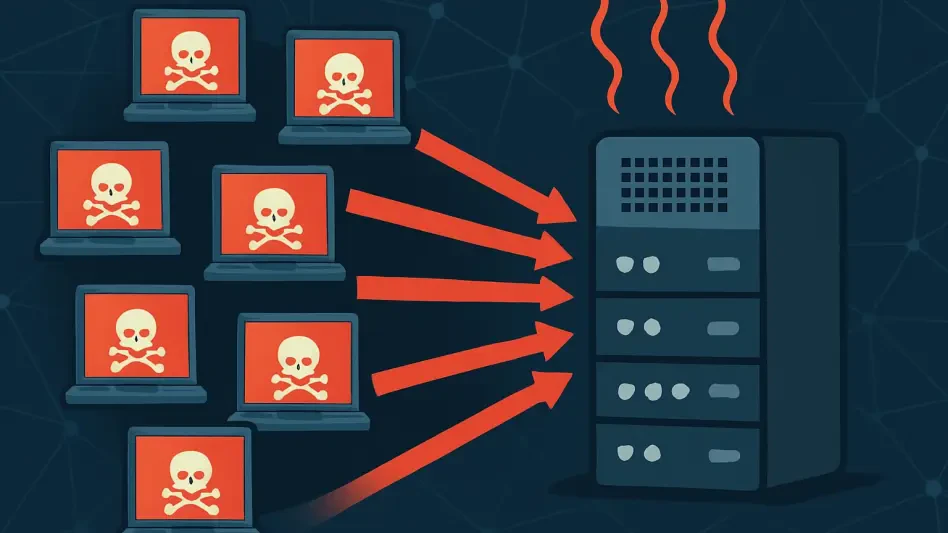In a digital landscape increasingly plagued by cyber threats, the emergence of the Rapper Bot DDoS botnet stood out as a particularly menacing force, striking fear into cybersecurity experts worldwide. Known for its staggering capacity to launch high-intensity Distributed Denial of Service (DDoS) attacks, this botnet, also referred to as the Eleven Eleven Botnet or CowBot, wreaked havoc across the globe by exploiting vulnerable Internet of Things (IoT) devices. Its dismantling by law enforcement represents a landmark victory in the ongoing battle against cybercrime. The operation not only halted a destructive network capable of generating attack traffic measured in terabits per second but also exposed the individual behind its creation. This significant takedown, achieved through meticulous investigation and international collaboration, underscores the persistent challenges of securing an interconnected world and the critical need for innovative defenses against evolving digital threats.
Unraveling the Scale of a Cyber Menace
The sheer magnitude of Rapper Bot’s operations painted a chilling picture of its destructive potential, positioning it as one of the most formidable botnets in recent memory. Over a short span, it orchestrated more than 370,000 attacks, targeting around 18,000 unique victims across 1,000 autonomous system numbers. Primarily infecting IoT devices like digital video recorders and Wi-Fi routers, the botnet amassed a staggering network of 65,000 to 95,000 compromised devices. These were weaponized to unleash DDoS attacks with traffic volumes ranging from two to three terabits per second, with one reported incident peaking beyond six terabits. Spanning 80 countries, the attacks hit hardest in regions like China, Japan, the United States, Ireland, and Hong Kong. Investigators estimate that millions of devices might have been infected over the botnet’s active period, potentially leading to millions of attacks, highlighting the urgent need to address vulnerabilities in everyday technology.
Beyond the raw numbers, the impact of Rapper Bot revealed a deeper systemic issue in the realm of cybersecurity. The botnet’s ability to exploit poorly secured IoT devices underscored how these often-overlooked gadgets can become powerful tools for cybercriminals. Each compromised device served as a node in a vast network designed to overwhelm targets, disrupting services and causing significant financial and operational damage. The global reach of the attacks demonstrated that no region was immune, with critical infrastructure and businesses alike bearing the brunt of the disruptions. This widespread threat emphasized the sophistication of modern cybercrime, where attackers leverage the sheer volume of connected devices to amplify their impact. The scale of this operation served as a wake-up call, pushing authorities and private entities to rethink strategies for protecting the digital ecosystem from such pervasive and powerful threats.
Tracking Down the Mastermind Behind the Botnet
The investigation into Rapper Bot’s origins led authorities to a 22-year-old individual from Eugene, Oregon, named Ethan Foltz, who was charged with aiding and abetting computer intrusions, an offense that could carry a 10-year prison sentence. Through painstaking digital forensics, law enforcement traced the botnet’s hosting provider to a PayPal account controlled by Foltz. This connection was further solidified by email addresses and IP activity linked to his personal accounts, despite his attempts to conceal his identity using VPN services. Additionally, his Google search history revealed over 100 queries related to “RapperBot,” often followed by visits to cybersecurity blogs, suggesting he was keenly aware of public discussions surrounding the botnet. This digital breadcrumb trail provided crucial evidence, painting a clear picture of his involvement in the creation and management of the malicious network.
Further breakthroughs came when the Defense Criminal Investigative Service (DCIS) executed a warrant at Foltz’s residence on August 6. During a recorded interview, he admitted to being the primary administrator of Rapper Bot, naming a partner known only as “SlayKings” and disclosing that the botnet’s code was adapted from earlier malicious programs like Mirai, Tsunami, and fBot. At the request of officials, Foltz disabled the botnet’s attack capabilities and handed over administrative control to DCIS personnel. Although he has not been arrested, a summons has been requested in the case. This admission and cooperation marked a turning point in the operation, allowing authorities to neutralize the immediate threat posed by the botnet. The case illustrates the power of combining technical expertise with traditional investigative methods to hold cybercriminals accountable, even as they attempt to operate in the shadows of the internet.
Collaborative Efforts and Broader Implications
The successful disruption of Rapper Bot was not the work of law enforcement alone but a testament to the strength of public-private partnerships in tackling cybercrime. Major technology companies, including Akamai, Amazon Web Services, Cloudflare, Digital Ocean, Flashpoint, Google, PayPal, and Unit 221B, played pivotal roles in supporting the investigation. Their expertise and resources were instrumental in mapping the botnet’s infrastructure, tracking its activities, and providing critical data that helped identify its operator. This collaboration highlights a growing recognition that the scale and sophistication of modern cyber threats require a united front, bridging the gap between governmental authority and private sector innovation. Such alliances are increasingly vital as botnets like Rapper Bot continue to evolve, exploiting new technologies and vulnerabilities at an alarming pace.
The broader implications of this case extend far beyond the immediate takedown, shedding light on the persistent vulnerabilities within IoT infrastructure. Rapper Bot’s reliance on compromised devices reflects a troubling trend where everyday technology becomes a gateway for massive cyberattacks. While the operation marked a significant achievement, the potential for millions of undetected infected devices suggests that the full extent of the damage may remain unknown. This reality calls for enhanced security measures, from stronger device manufacturing standards to better user education on safeguarding connected gadgets. The fight against such threats demands ongoing vigilance, with an emphasis on developing proactive defenses to stay ahead of cybercriminals who continuously adapt and refine their tactics based on existing malicious frameworks.
Reflecting on a Milestone in Cybersecurity
Looking back, the dismantling of Rapper Bot stood as a defining moment in the relentless struggle against digital threats, achieved through detailed investigative work and unprecedented cooperation across borders and sectors. The operation not only neutralized a botnet capable of catastrophic disruption but also set a precedent for holding individuals accountable for cybercrimes of immense scale. Moving forward, the focus must shift to actionable strategies, such as bolstering IoT security protocols and fostering greater collaboration between stakeholders to prevent similar threats from emerging. Governments, tech companies, and users alike need to prioritize the development of robust safeguards and rapid response mechanisms. This victory, while significant, served as a reminder that the landscape of cybercrime is ever-changing, requiring constant adaptation and investment in cutting-edge solutions to protect the integrity of a connected world.








